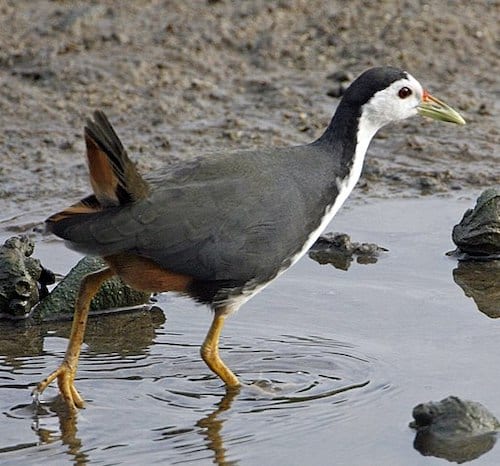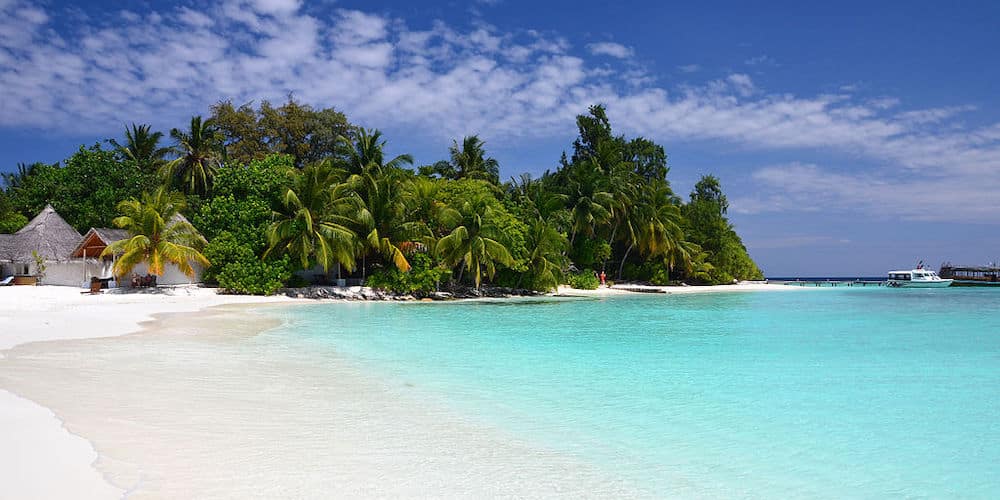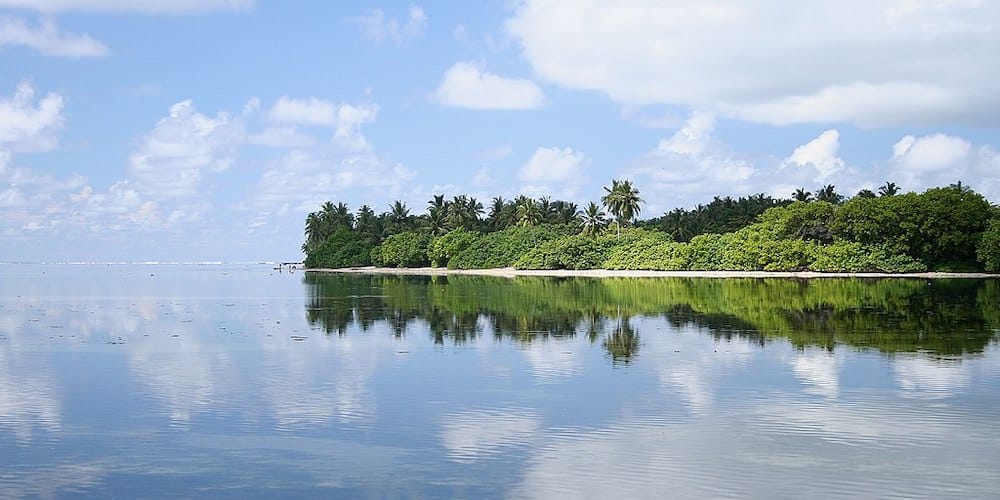Republic of Maldives

The Maldives, historically known as the Maldive Islands, is a country and archipelagic state in South Asia in the Indian Ocean. It is southwest of Sri Lanka and India, about 750 kilometres (470 miles) from the Asian continent’s mainland. The chain of 26 atolls stretches across the equator from Ihavandhippolhu Atoll in the north to Addu Atoll in the south. It is the smallest country in Asia by land area. Including the sea, the territory spans roughly 90,000 km2 (35,000 square miles), with a land area of less than 300 km2 (115 square miles). It is one of the world’s most geographically dispersed sovereign states. With a population of a little under 530,000 people, it is the second least populous country in Asia and the ninth-smallest country by total area, but also one of the most densely populated countries. The Maldives has an average ground-level elevation of 1.5 metres (5 feet) above sea level, and a highest natural point of only 2.4 metres, making it the world’s lowest-lying country. In areas where construction exists, however, this has been increased to several metres. Some sources state the highest point, Mount Villingili, as 5.1 metres or 17 feet. Malé is the capital and the most populated city, traditionally called the ‘King’s Island’, where the ancient royal dynasties ruled from its central location.
The Maldives is a chain of 26 coral atolls formed upon minor elevations on the Chagos-Lacadive submarine plateau, which ascends from the deep Indian Ocean. The plateau has provided a base for the reef building corals, from where they have risen to the surface. There are a total of 1,192 coral islands made up of 200 inhabited islands, plus 80 islands with tourist resorts. All of them are surrounded by natural reefs, which serve as the only protection against rough seas.
The islands are generally flat with very few mounds. There are no hills, mountains or rivers. Some of the larger islands have small fresh-water lakes while others have brackish water with mangroves along the edges. Only near the southern end of this natural coral barricade do two open passages permit safe ship navigation from one side of the Indian Ocean to the other through the territorial waters of the Maldives. The largest island of the Maldives is that of Gan, which belongs to Laamu Atoll or Hahdhummathi Maldives. In Addu Atoll, the westernmost islands are connected by roads over the reef (collectively called Link Road) and the total length of the road is 14 km (9 miles).

Bathala Island Beach – ©Gzzz CC BY-SA 4.0 via Wikimedia Commons
Threats for the island are depletion of freshwater aquifers which threatens water supplies, global warming and sea level rise (80% of the area is one meter or less above sea level) and coral reef bleaching. If sea levels continue to rise at the current rate the islands will be uninhabitable by 2100.
The Maldives has a tropical monsoon climate, which is affected by the large landmass of South Asia to the north. Because the Maldives has the lowest elevation of any country in the world, the temperature is constantly hot and often humid. The presence of this landmass causes differential heating of land and water. These factors set off a rush of moisture-rich air from the Indian Ocean over South Asia, resulting in the southwest monsoon. Two seasons dominate the Maldives’ weather: the dry season associated with the winter northeastern monsoon and the rainy season associated with the southwest monsoon which brings strong winds and storms. The shift from the dry northeast monsoon to the moist southwest monsoon occurs during April and May. During this period, the southwest winds contribute to the formation of the southwest monsoon, which reaches the Maldives at the beginning of June and lasts until the end of November. However, the weather patterns of the Maldives do not always conform to the monsoon patterns of South Asia. The annual rainfall averages 100 inches in the north and 150 inches in the south. The average high temperature is 31.5 °C and the average low temperature is 26.4 °C.
Over 90% of government tax revenue comes from import duties and tourism-related taxes. Almost 400,000 tourists visited the islands in 1998. Fishing is a second leading sector. The wildlife of the Maldives includes the flora and fauna of the islands, reefs, and the surrounding ocean. Recent scientific studies suggest that the fauna varies greatly between atolls following a north–south gradient, but important differences between neighbouring atolls were also found (especially in terms of sea animals), which may be linked to differences in fishing pressure including poaching.
Birding the Maldives
The terrestrial habitats of the Maldives are confronted with a significant threat as extensive development encroaches swiftly upon the limited land resources. Once seldom frequented, previously uninhabited islands now teeter on the brink of extinction, virtually devoid of untouched expanses. Over recent decades of intensive development, numerous natural environments crucial to indigenous species have suffered severe endangerment or outright destruction. The waters surrounding the Maldives boast an extensive array of marine life, showcasing a vibrant tapestry of corals and over 2,000 species of fish.
The location of this Indian Ocean archipelago means that its avifauna is mainly restricted to pelagic birds. Most of the species are Eurasian migratory birds, only a few being typically associated with the Indian sub-continent. Some, like frigatebird are seasonal. There are also birds that dwell in marshes and island bush, such as grey heron and moorhen. White terns are found occasionally on the southern islands due to their rich habitats.

©Mark Hodson Photos CC BY 2.0 via Wikimedia Commons
There are few ways to get to these island. Most people book either a trip to the Maldives alone or one combined with Sri Lanka. When you book to the Maldives it has to be a package that includes transportation to the island, accommodation, breakfast and supper. Notice that drinks and food other than breakfast and supper are not for free, and prices are fairly high. Wherever you stay you can go on snorkelling or sightseeing trips, these are not expensive and can bring you some great pelagic species.
Birding trip reports from the Maldives are few and far between. A good source of information can be found in several chapters of The Birds of the Indian Subcontinent by Grimmett, Inskipp and Inskipp. They state a total of 144 species ever recorded, and most of these species are shorebirds and vagrants. However, the Oriental Bird Club put it at 182 (2012) and other sources say around 200. Few birds breed there but Crab-plover, Lesser Frigatebird, White Tern and Audubon’s Shearwater are the most spectacular breeders. There are no known endemics on the island. However, it cannot be doubted that some islands are still unexploited for their birding potential. For example, our contributor saw two new species for the Maldives on his trip – Rain Quail and Citrine Wagtail!
-
Number of bird species: 206
(As at January 2025)State Bird - White-breasted Waterhen Amaurornis phoenicurus
-
Avibase
PDF ChecklistThis checklist includes all bird species found in Maldives , based on the best information available at this time. It is based on a wide variety of sources that I collated over many years. I am pleased to offer these checklists as a service to birdwatchers. If you find any error, please do not hesitate to report them. -
Wikipedia
Annotated ListThe following is a list of birds recorded in the Maldives. The small size and isolation of this Indian Ocean republic mean that its avifauna is extremely restricted. Most of the species are characteristic of Eurasian migratory birds, with only a few typically associated with the Indian subcontinent. The avifauna of the Maldives includes a total of 205 species, of which 4 have been introduced by humans. Four species are globally threatened. -
eBird
PDF ChecklistThis checklist is generated with data from eBird (ebird.org), a global database of bird sightings from birders like you. If you enjoy this checklist, please consider contributing your sightings to eBird. It is 100% free to take part, and your observations will help support birders, researchers, and conservationists worldwide.
-
A Photographic Guide to Birds of India
(And the Indian Subcontinent, Including Pakistan, Nepal, Bhutan, Bangladesh, Sri Lanka & the Maldives) | By Bikram Grewal, Bill Harvey & Otto Pfister | Timeless Books | 2011 | Paperback | 512 pages, 850 colour photos, 800 colour distribution maps | ISBN: 9788189497255 Buy this book from NHBS.com
-
NR Baa Atoll
InformationSatellite ViewSituated on the west of the Maldives atoll chain, it consists of 75 islands of which 13 are inhabited with a population of over 11,000 people. The remaining 57 islands are uninhabited, in addition to eight islands being developed as resorts. The southernmost uninhabited island of Olhugiri in the North Maalhosmadulu Atoll lies 13 km north of Goifulhafehendhu Atoll. Olhugiri is well known for its unique natural vegetation and for providing two of the only perching sites for the great frigatebird in the Maldives. Likewise, other marine creatures such as seaturtles and hawksbill turtles can be encountered.
-
NatureTrek
Tour OperatorThe Maldives lie nearly 600 kilometres to the south-west of India. Many of the 1,192 islands that make up the archipelago (only 300 are inhabited) are ringed by pristine coral reefs famous for their marine-life. -
Rockjumper
Tour OperatorThe Maldives - Cetacean & Seabird Cruise 2025
-
2014 [02 February] - David Karr - Gan Island & Addu Atoll
PDF Report…Also on my hit list were White-tailed Tropicbird and the Crab Plover. I scored two out of three and also four other (unexpected) lifers: Curlew Sandpiper, Saunders’ Tern, Montagu’s Harrier and a Shearwater… -
2018 [03 March] - Sara Frost
PDF Report...We then had breakfast (delicious pancakes, cheese omelettes, cereals, tropical fruits, fresh juices, toast and tea and coffee) and continued to sail to the south of Ari Atoll. Spinner Dolphins made a welcome appearance alongside the boat, and we also saw Black-naped, Greater and Lesser-crested Terns and a Grey Heron... -
2018 [04 April] - Jonathan Taylor
PDF ReportMain reason for trip was to finish our open water diving training whilst knowing that a few really nice sub-continental ticks could be easily seen. Trip reports to the Maldives though are almost nonexistent so hopefully this one will add some value to out-going Indian birders wanting to add an extension to a Sri Lankan bird trip. -
2019 [02 February] - Sara Frost
PDF ReportMantas, Dolphins & Coral Reefs – A Maldives Cruise

